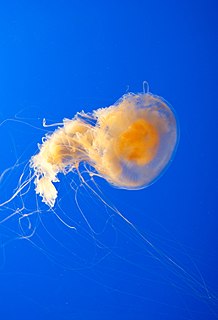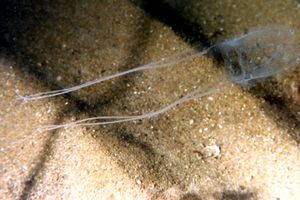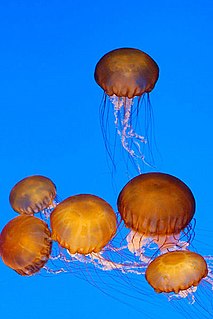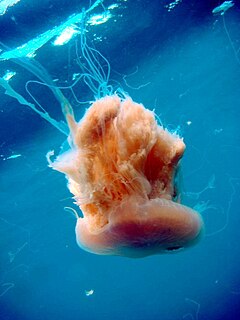
Cnidaria is a phylum under kingdom Animalia containing over 11,000 species of aquatic animals found both in freshwater and marine environments, predominantly the latter.

Jellyfish and sea jellies are the informal common names given to the medusa-phase of certain gelatinous members of the subphylum Medusozoa, a major part of the phylum Cnidaria. Jellyfish are mainly free-swimming marine animals with umbrella-shaped bells and trailing tentacles, although a few are anchored to the seabed by stalks rather than being mobile. The bell can pulsate to provide propulsion for highly efficient locomotion. The tentacles are armed with stinging cells and may be used to capture prey and defend against predators. Jellyfish have a complex life cycle; the medusa is normally the sexual phase, which produces planula larva that disperse widely and enter a sedentary polyp phase before reaching sexual maturity.

The Scyphozoa are an exclusively marine class of the phylum Cnidaria, referred to as the true jellyfish. It may include the extinct fossil group the Conulariida, whose affinities are uncertain and widely debated.

Box jellyfish are cnidarian invertebrates distinguished by their box-like body. Some species of box jellyfish produce potent venom delivered by contact with their tentacles. Stings from some species, including Chironex fleckeri, Carukia barnesi, Malo kingi, and a few others, are extremely painful and often fatal to humans.

Aurelia aurita is a widely studied species of the genus Aurelia. All species in the genus are very similar, and it is difficult to identify Aurelia medusae without genetic sampling; most of what follows applies equally to all species of the genus. The most common method used to identify the species consists of selecting a jellyfish from a harbour using a device, usually a drinking glass and then photographing the subject. This means that they can be released in to the harbour shortly afterwards and return to their natural habitat.

Medusozoa is a clade in the phylum Cnidaria, and is often considered a subphylum. It includes the classes Hydrozoa, Scyphozoa, Staurozoa and Cubozoa, and possibly the parasitic Polypodiozoa. Medusozoans are distinguished by having a medusa stage in their often complex life cycle, a medusa typically being an umbrella-shaped body with stinging tentacles around the edge. With the exception of some Hydrozoa, all are called jellyfish in their free-swimming medusa phase.

Jellyfish Lake is a marine lake located on Eil Malk island in Palau. Eil Malk is part of the Rock Islands, a group of small, rocky, mostly uninhabited islands in Palau's Southern Lagoon, between Koror and Peleliu. There are about 70 other marine lakes located throughout the Rock Islands. Millions of golden jellyfish migrate horizontally across the lake daily.

Phacellophora camtschatica, commonly known as the fried egg jellyfish or egg-yolk jellyfish, is a very large jellyfish in the family Phacellophoridae. This species can be easily identified by the yellow coloration in the center of its body which closely resembles an egg yolk, hence how it got its common name. Some individuals can have a bell close to 60 cm (2 ft) in diameter, and most individuals have 16 clusters of up to a few dozen tentacles, each up to 6 m (20 ft) long. A smaller jellyfish, Cotylorhiza tuberculata, typically found in warmer water, particularly in the Mediterranean Sea, is also popularly called a fried egg jellyfish. Also, P. camtschatica is sometimes confused with the Lion's mane jellyfish.

Carybdea is a genus of venomous box jellyfish within the family Carybdeidae that currently consists of a total of 8 species. This genus of jellyfish are often found in warm waters around the world in waters such as the Mediterranean Sea, the Pacific Ocean, and off the coast of Africa. Their sting can cause a range of effects depending on the species. These invertebrates will go through both sexual and asexual reproduction as they transform from a polyp to medusa. Carybdea have a box-shaped bell with four tentacles and eye-like sensory structures. There are distinct physical markings that differentiate many species within the genus. While Carybdea use their venom to act as predators, they are also preyed on by turtles and various fish. They feed on plankton, invertebrates, fish, and some crustaceans.

Cotylorhiza tuberculata is a species of jellyfish, of the phylum Cnidaria, also known as the Mediterranean jellyfish, Mediterranean jelly or fried egg jellyfish. It is commonly found in the Mediterranean Sea, Aegean Sea, and Adriatic Sea.

Cotylorhiza is a genus of true jellyfish from the family Cepheidae. The genus is found in the central-east Atlantic, Mediterranean, and western Indian Ocean.

Chrysaora is a genus of jellyfish, commonly called the sea nettles, in the family Pelagiidae. The origin of the genus name Chrysaora lies in Greek mythology with Chrysaor, brother of Pegasus and son of Poseidon and Medusa. Translated, Chrysaor means "he who has a golden armament."

Turritopsis dohrnii, also known as the immortal jellyfish, is a species of small, biologically immortal jellyfish found worldwide in temperate to tropic waters. It is one of the few known cases of animals capable of reverting completely to a sexually immature, colonial stage after having reached sexual maturity as a solitary individual. Others include the jellyfish Laodicea undulata and species of the genus Aurelia.

Aurelia is a genus of scyphozoan jellyfish, commonly called moon jellies. There are currently 25 accepted species and many that are still not formally described.

Cyanea is a genus of jellyfish, primarily found in northern waters of the Atlantic and Pacific Oceans and southern Pacific waters of Australia and New Zealand, there are also several boreal, polar, tropical and sub-tropical species. Commonly found in and associated with rivers and fjords. The same genus name has been given to a genus of plants of the Hawaiian lobelioids, an example of a parahomonym.

Drymonema is a genus of true jellyfish, placed in its own family, the Drymonematidae. There are three species: Drymonema dalmatinum, Drymonema gorgo, and Drymonema larsoni, which are found in the Gulf of Mexico, Atlantic Ocean and Mediterranean Sea.

The helmet jellyfish is a luminescent, red-colored jellyfish of the deep sea, belonging to the order Coronatae of the phylum Cnidaria. It is the only species in the monotypic genus Periphylla. They are the only known scyphozoan to undergo sexual propagation that lacks a planula stage. Not only is their reproductive cycle unique, so are their living conditions. They are found in deeper parts of the ocean due to them being photophobic.

Chiropsoides is a genus of box jellyfish in the family Chiropsalmidae. It is monotypic, with a single species, Chiropsoides buitendijki. The most distinct species characteristics are the shape of the gastric saccules, the pedalial canals, and the unilateral pedalial branching.
Chiropsella bronzie is a species of box jellyfish. It is considered much less of a threat to humans than some of its relatives. The species was described in 2006, and is one of four species in the genus Chiropsella. Chiropsella bronzie can be found in shallow waters off the coast of Queensland, Australia.



















